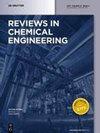Principles of reverse electrodialysis and development of integrated-based system for power generation and water treatment: a review
IF 4.9
3区 工程技术
Q1 ENGINEERING, CHEMICAL
引用次数: 13
Abstract
Abstract Reverse electrodialysis (RED) is among the evolving membrane-based processes available for energy harvesting by mixing water with different salinities. The chemical potential difference causes the movement of cations and anions in opposite directions that can then be transformed into the electrical current at the electrodes by redox reactions. Although several works have shown the possibilities of achieving high power densities through the RED system, the transformation to the industrial-scale stacks remains a challenge particularly in understanding the correlation between ion-exchange membranes (IEMs) and the operating conditions. This work provides an overview of the RED system including its development and modifications of IEM utilized in the RED system. The effects of modified membranes particularly on the psychochemical properties of the membranes and the effects of numerous operating variables are discussed. The prospects of combining the RED system with other technologies such as reverse osmosis, electrodialysis, membrane distillation, heat engine, microbial fuel cell), and flow battery have been summarized based on open-loop and closed-loop configurations. This review attempts to explain the development and prospect of RED technology for salinity gradient power production and further elucidate the integrated RED system as a promising way to harvest energy while reducing the impact of liquid waste disposal on the environment.反电渗析原理与发电和水处理一体化系统的发展综述
摘要反向电渗析(RED)是一种不断发展的基于膜的工艺,可通过混合不同盐度的水来获取能量。化学电势差导致阳离子和阴离子沿相反方向移动,然后通过氧化还原反应在电极处转化为电流。尽管一些工作已经表明了通过RED系统实现高功率密度的可能性,但向工业规模堆叠的转变仍然是一个挑战,特别是在理解离子交换膜(IEM)和操作条件之间的相关性方面。本工作概述了RED系统,包括其在RED系统中使用的IEM的开发和修改。讨论了改性膜的影响,特别是对膜的心理化学性质的影响,以及许多操作变量的影响。基于开环和闭环配置,总结了RED系统与反渗透、电渗析、膜蒸馏、热机、微生物燃料电池和液流电池等其他技术相结合的前景。这篇综述试图解释RED技术在盐度梯度发电中的发展和前景,并进一步阐明集成RED系统是一种很有前途的获取能源的方法,同时减少液体废物处理对环境的影响。
本文章由计算机程序翻译,如有差异,请以英文原文为准。
求助全文
约1分钟内获得全文
求助全文
来源期刊

Reviews in Chemical Engineering
工程技术-工程:化工
CiteScore
12.30
自引率
0.00%
发文量
37
审稿时长
6 months
期刊介绍:
Reviews in Chemical Engineering publishes authoritative review articles on all aspects of the broad field of chemical engineering and applied chemistry. Its aim is to develop new insights and understanding and to promote interest and research activity in chemical engineering, as well as the application of new developments in these areas. The bimonthly journal publishes peer-reviewed articles by leading chemical engineers, applied scientists and mathematicians. The broad interest today in solutions through chemistry to some of the world’s most challenging problems ensures that Reviews in Chemical Engineering will play a significant role in the growth of the field as a whole.
 求助内容:
求助内容: 应助结果提醒方式:
应助结果提醒方式:


